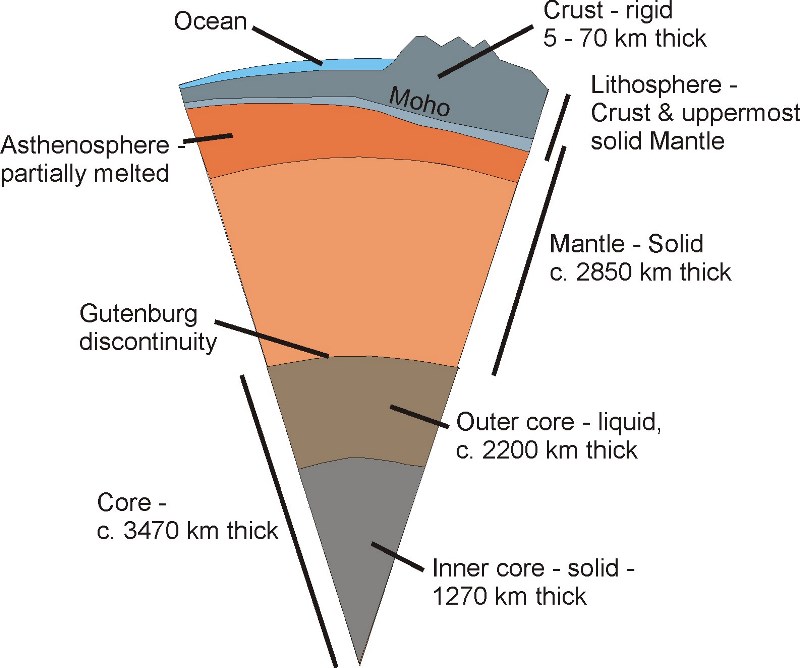Scientists find iron 'snow' in Earth's core: Study "EMPOWER IAS"
In news:
- The researchers, including those from the University of Texas at Austin in the US, studied this layer by recording and analysing signals from seismic waves as they passed through the Earth.
Key findings of the study:
- The Earth's deepest layer, the inner core, is capped by snow made of tiny particles of iron, which are much heavier than the snowflakes seen in the atmosphere, a new study says.
- According to the study published in the journal JGR Solid Earth, the iron-snow falls from the molten outer core, and piles up on top of the inner core, creating stacks up to 200 miles thick which cover the innermost layer of the planet.
- Researchers found variations between recent seismic wave data, and the values they expected based on mathematical models of the Earth's core, raising new questions.
- One of their observations was that the seismic waves moved much slower than expected when they passed through the base of the outer core, and they moved faster than estimates as they passed through the eastern hemisphere of the top inner core.
- Based on these findings, the study proposed the iron snow-capped core as an explanation for these aberrations.
- Earlier studies had pointed that a slurry layer exists between the inner and outer core, however the existing knowledge at that time about heat and pressure conditions in the core quashed that theory.
- With new data from experiments on core-like materials, the scientists found that crystallisation was possible and that about 15 per cent of the lowermost outer core could be made of iron-based crystals.
- According to the researchers, accumulated snow pack may be the cause of the seismic aberrations.
- The core has significant influence over processes that affect the entire planet -- from generating its magnetic field to radiating the heat that drives the movement of tectonic plates , understanding more about its composition could help in unravelling mysteries about these larger processes.
Internal Structure of the Earth:
- The earth is made up of three different layers: the crust, the mantle and the core

Crust
- It is the outermost solid part of the earth, normally about 8-40 kms thick.
- It is brittle in nature.
- Nearly 1% of the earth’s volume and 0.5% of earth’s mass are made of the crust.
- The thickness of the crust under the oceanic and continental areas are different. Oceanic crust is thinner (about 5kms) as compared to the continental crust (about 30kms).
- Major constituent elements of crust are Silica (Si) and Aluminium (Al) and thus, it is often termed as SIAL (Sometimes SIAL is used to refer Lithosphere, which is the region comprising the crust and uppermost solid mantle, also).
- The mean density of the materials in the crust is 3g/cm3.
- The discontinuity between the hydrosphere and crust is termed as the Conrad Discontinuity.
Mantle
- The portion of the interior beyond the crust is called the mantle. The mantle extends from Moho’s discontinuity (boundary between the crust and mantle) to a depth of 2,900 km.
- The crust and the uppermost part of the mantle are called lithosphere. Its thickness ranges from 10-200 km.
- The upper portion of the mantle is called asthenosphere which is the main source of magma that finds its way to the surface during volcanic eruptions.
- The lower mantle extends beyond the asthenosphere. It is in solid state.
Core:
- It is the innermost layer surrounding the earth’s centre.
- The core is separated from the mantle by Guttenberg’s Discontinuity.
- It is composed mainly of iron (Fe) and nickel (Ni) and hence it is also called as NIFE.
- The core constitutes nearly 15% of earth’s volume and 32.5% of earth’s mass.
- The core is the densest layer of the earth with its density ranges between 9.5-14.5g/cm3.
- The Core consists of two sub-layers: the inner core and the outer core.
- The inner core is in solid state and the outer core is in the liquid state (or semi-liquid).
- The discontinuity between the upper core and the lower core is called as Lehmann Discontinuity.
- Barysphere is sometimes used to refer the core of the earth or sometimes the whole interior.

Source)https://www.business-standard.com/article/pti-stories/earth-s-innermost-layer-is-capped-by-iron-snow-study-119122000695_1.html

